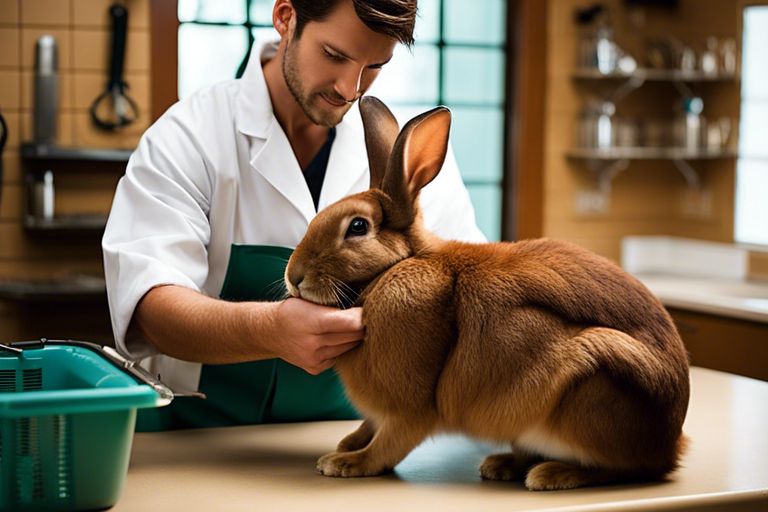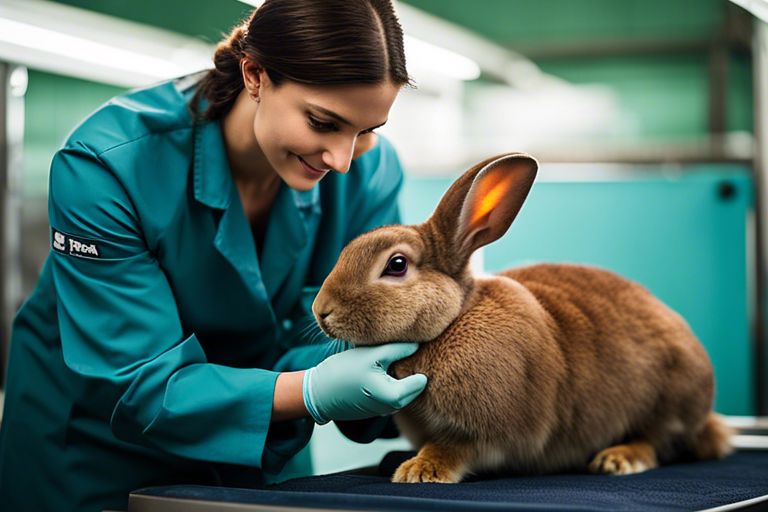There is a remarkable relationship between grooming and detecting early signs of illness in Flemish Giants. As large rabbits, Flemish Giants are prone to various health issues that can be dangerous if not detected early. Grooming your Flemish Giant regularly can positively impact their overall health and help you notice any changes in their fur, skin, or body condition that may indicate an underlying health problem. In this blog post, we will explore how grooming can aid in the early detection of illness in Flemish Giants and what signs to look out for during grooming sessions.
Key Takeaways:
- Grooming behaviors can help detect early signs of illness in Flemish Giants, such as changes in fur texture or appearance.
- Regular grooming sessions allow rabbit owners to closely observe their pet’s physical condition and identify any abnormal signs or symptoms.
- Early detection of illness is crucial in rabbits, as they are skilled at hiding symptoms until the condition becomes severe.
- A proactive approach to grooming and monitoring a Flemish Giant’s health can lead to prompt veterinary care and better treatment outcomes.
- Consulting with a veterinarian can provide rabbit owners with additional guidance on grooming practices and signs of illness to watch for.
Understanding Flemish Giant Rabbits
One of the most iconic and sought-after rabbit breeds, the Flemish Giant is known for its impressive size and gentle demeanor. Originally bred for their meat and fur, these rabbits have become popular as pets due to their docile nature and lovable characteristics.
Characteristics of the Flemish Giant breed
Understanding the characteristics of the Flemish Giant breed is essential for anyone considering bringing one into their home. These rabbits are known for their impressive size, with males weighing in at around 15 pounds and females reaching up to 20 pounds. Their calm and friendly disposition makes them great companions, especially for families with children. These rabbits have a distinctive appearance with their large, powerful bodies and ears that stand upright.
Common health issues in Flemish Giants
With their large size, Flemish Giants are prone to certain health issues that potential owners should be aware of. These include obesity, which can lead to a range of other health problems, as well as gastrointestinal stasis and pododermatitis due to their size and weight. It’s important for owners to monitor their rabbit’s diet and ensure they have plenty of space to exercise to prevent these issues.
Giant rabbits require regular grooming and attention to their overall well-being to help prevent potential health problems. By understanding the unique needs of the breed, owners can ensure that their Flemish Giants live long, healthy lives.

Grooming Techniques
Some rabbit breeds, such as the Flemish Giants, require regular grooming to maintain their health and well-being. Grooming can also be a valuable tool for detecting early signs of illness. By observing the rabbit’s coat, skin, and overall appearance during grooming sessions, owners and veterinarians may be able to identify potential health issues before they become serious. For more information on common rabbit disorders and diseases, visit Disorders and Diseases of Rabbits – All Other Pets.
Basic grooming steps for Flemish Giants
Grooming should begin with a thorough inspection of the rabbit’s coat, skin, and overall body condition. This includes checking for any signs of parasites, skin irritation, or unusual lumps or bumps. Regular brushing and nail trimming should also be part of the grooming routine to prevent matting and overgrown nails, which can lead to discomfort and health issues.
Advanced grooming practices for health assessment
Basic grooming practices should be supplemented with advanced techniques for a more thorough health assessment. This may include examining the rabbit’s eyes, ears, and teeth, as well as palpating the abdomen and checking for any unusual odors or discharge. These practices can help detect early signs of dental problems, ear infections, digestive issues, and other health concerns.
| Health Assessment Techniques | Description |
| Eye examination | Check for cloudiness, discharge, or signs of injury or infection. |
| Ear inspection | Look for redness, swelling, or excessive wax buildup. |
| Dental assessment | Inspect teeth for overgrowth, malocclusion, or signs of dental disease. |
| Abdominal palpation | Feel for any abnormal masses, bloating, or discomfort in the abdomen. |
Indicators of Illness During Grooming
Your Flemish Giant rabbit’s regular grooming routine can provide early warning signs of potential health issues. By paying attention to both physical and behavioral cues during grooming sessions, you can better detect any potential illness and seek veterinary care promptly.
Physical signs to watch for
The physical condition of your Flemish Giant during grooming can reveal a lot about its overall health. Be on the lookout for changes in fur quality, such as dullness, matting, or hair loss, which could indicate nutritional deficiencies or an underlying health issue . In addition, check for any lumps, bumps, or unusual skin discoloration, which could be a sign of a tumor or skin infection. Keep an eye out for overgrown or broken nails, as well as any discharge from the eyes, nose, or ears, as these could also be indicative of illness.
Behavioral cues that suggest illness
One of the most important aspects of grooming is observing your Flemish Giant’s behavior. Changes in grooming habits, such as decreased self-grooming or spending more time grooming a particular area, can signal discomfort or pain. Watch for changes in appetite, drinking, or elimination habits, as well as any lethargy or unusual posture, which could indicate digestive problems or musculoskeletal issues.
With proper attention to these physical and behavioral cues during grooming, you can stay proactive in monitoring your Flemish Giant’s health. Being aware of these potential signs can help you detect illness early and provide the best care for your beloved pet.
Integrating Grooming and Health Checks
For owners of Flemish Giants, grooming is not just about keeping their rabbit’s fur clean and free of mats. It also provides an excellent opportunity to closely monitor their pet’s overall health. By integrating grooming with regular health checks, owners can potentially detect early signs of illness and take proactive measures to ensure their rabbit’s well-being.
Creating a routine for consistent monitoring
Integrating grooming and health checks into a consistent routine is essential for effectively monitoring the health of Flemish Giants. Set aside dedicated time each week for grooming sessions, using this opportunity to observe your rabbit’s behavior and physical condition. By consistently monitoring your rabbit, you can quickly identify any changes or abnormalities that may indicate an underlying health issue. This proactive approach can help catch potential illnesses in their early stages, allowing for prompt veterinary care.
Recording observations and when to seek veterinary care
To ensure thorough monitoring, it is important to record your observations during grooming and health checks. Document any changes in behavior, appetite, water intake, and stool consistency. Keep track of any unusual lumps, bumps, or changes in fur quality. If you observe any concerning symptoms or noticeable changes in your rabbit’s overall condition, it is crucial to seek veterinary care immediately to address any potential health issues promptly.
Observations during grooming and health checks serve as vital indicators of your Flemish Giant’s well-being. Paying close attention to these details, such as changes in behavior and physical appearance, can aid in early detection of illness and contribute to maintaining your rabbit’s health.

Can grooming help detect early signs of illness in Flemish Giants?
From above evidence, it is clear that grooming can indeed assist in detecting early signs of illness in Flemish Giants. The attentive and regular grooming process allows for close inspection of the rabbit’s body, enabling owners to notice any changes in physical appearance, behavior, or health. By understanding the typical grooming habits of these rabbits and using it as a tool for early detection, owners can take proactive measures to ensure the well-being and health of their beloved pets. As responsible caretakers, it is crucial to remain observant and proactive in maintaining the health and happiness of our furry friends, and grooming offers an essential avenue for achieving this goal.
FAQ
Q: Can grooming help detect early signs of illness in Flemish Giants?
A: Yes, regular grooming can help detect early signs of illness in Flemish Giants. By observing changes in grooming habits, such as reduced grooming or areas of increased sensitivity, you can identify potential health issues early on.
Q: What are some signs of illness to look for during grooming sessions with a Flemish Giant?
A: Some signs of illness to look for during grooming sessions with a Flemish Giant include changes in skin condition, such as dryness or flakiness, lumps or bumps, changes in fur texture or color, and signs of pain or discomfort during grooming.
Q: How often should I groom my Flemish Giant to monitor their health?
A: It is recommended to groom your Flemish Giant at least once a week to monitor their health. This regular grooming routine allows you to closely observe any changes in their appearance, behavior, or physical condition, and promptly address any potential health concerns.
